Visual arts and eroticism
By Alex Ionescu

“… beauty is not a need, but an ecstasy,
it is not a thirsting mouth, nor an empty hand stretched forth,
But rather a heart enflamed and a soul enchanted.
It is not the image you would see or the song you would hear,
But rather an image you see though you close your eyes,
and a song you hear though you shut your ears.
It is not the sap within the furrowed bark, nor a wing attached to a
claw,
But rather a garden forever in bloom and a flock of angels forever
in flight.
Beauty is life when life unveils her holy face.”
– Khalil Gibran, The Prophet
Consciously or not, many people regain their inner balance and harmony watching or appreciating beauty. It is rather natural if we consider the fact that human psychic “feeds” itself with all the information received from the senses and the emotions that occur. Due to the fact that 70-90% of all the information the brain receives is visual, we can easily understand why it is highly necessary for us to watch things or beings, beautiful landscapes, especially when we’re feeling “blue”.
Even in ancient times, people appreciated and praised beauty in different ways and in each shape it was expressed – through dance, painting or sculpture, through inspired songs or through theatre. The contemplation of each manifestation of beauty induces profound states of consciousness, unique and ineffable feelings.
In ancient times people emphasized a lot the physical movements, as through them they could express nobleness, beauty, perfection of the spirit. The art of movement through dance and theatre was considered a way to induce extraordinary beautiful and high spiritual states in the audience. In all civilizations where spirituality blossomed in the past, the initiate erotic dance was considered a wonderful gift for evolution. In time, the degeneration of the deep, initiate nature of erotic dance shows towards that which we call today “striptease” only reveals the dramatic decrease of the level of consciousness of the human being, which made that what once was sublime and deeply transforming to become trivial and ordinary shows, that only aim towards sexual stimulation. In the same way theatre, that was meant to send profound spiritual teachings in the past and show people how to live a harmonious life, became just a pale shadow of what once was, nowadays often being only “fun”.
The erotic dance
 Full of life and passion, dance is one of the most beautiful of arts. Aristotle said that dance has its origin in the rhythm of the heartbeats. The need for dancing is the human need for rhythm. Dance offers various satisfactions, without forgetting the aesthetic ones. It teaches us to be harmonious in the whole language of gestures. Dance is emotion, the courage to surpass the spirit’s immobility and to manifest the life and the spark that burns inside our soul.
Full of life and passion, dance is one of the most beautiful of arts. Aristotle said that dance has its origin in the rhythm of the heartbeats. The need for dancing is the human need for rhythm. Dance offers various satisfactions, without forgetting the aesthetic ones. It teaches us to be harmonious in the whole language of gestures. Dance is emotion, the courage to surpass the spirit’s immobility and to manifest the life and the spark that burns inside our soul.
This passion manifests especially through erotic dance. Both men and women think that this type of dance, which is the substance of many performances, is more stimulating and exciting. “There are many forms of erotic dance, according to their rhythm and expression, for example “belly dance”, flamenco, can-can and so on. One of the most famous and sensual ones is belly dance, known from ancient times. In the beginning it was performed by women for women, particularly for those who were pregnant and it was meant to relax and help them during labor. The dance tones and strengthens the abdominal muscles; it deeply massages the abdominal organs, improving blood circulation in all the tissues and ligaments, the pelvis area having most of the benefits from it.” (Extract from the work The Natural Encyclopedia of Aphrodisiacs, by YOGA teacher Gregorian Bivolaru).
“Just like lovemaking, dance, in its highest manifestation, is an expression of love. There are erotic Indian dances which are known to recall certain erotic postures, thus stimulating the imagination and the desire in the lovers.” (Extract from the work The Natural Encyclopedia of Aphrodisiacs, by YOGA teacher Gregorian Bivolaru).
In the Orient, thousands of years ago, a show that the contemporary ignorance might call “striptease” had the esoteric initiating role of the Self – revelation. Those who watched these type of rituals experienced in the end a profound state of divine ecstasy in the moment when the woman, intensively transfigured, showed her body in all its splendor and perfection, after removing all that covered her – which symbolized, in fact, the subtle covers of human being – in the end revealing to the viewers the divine essence of manifested being.
“The Indian temple dancers or the so-called DEVADASI were divided in different categories. Experts in certain secret tantric branches made the most elevated category, and after years of practice, those dancers developed and perfected very good control upon different bodily functions.
The courts of kings and emperors were filled with very beautiful and deeply sensual women dancers, who were meant to stir erotic feelings and induce spiritual states of love in all those present, sublimating the raw sexual energy and impelling spiritual progress.
 In ancient Egypt, the beautiful court dancers or temple dancers were considered to have power over life and death; many of them became as influential as priestesses, because dance is the most adequate art form to express esoteric concepts which cannot be described by words and static images. Dance embodies in a very special way the entire scale of emotions; thus, it is able to reveal The Subtle Body of Tantra in its brightness.” (extract from The Alchemy of Ecstasy, volume II, by Nick Douglas and Penny Slinger).
In ancient Egypt, the beautiful court dancers or temple dancers were considered to have power over life and death; many of them became as influential as priestesses, because dance is the most adequate art form to express esoteric concepts which cannot be described by words and static images. Dance embodies in a very special way the entire scale of emotions; thus, it is able to reveal The Subtle Body of Tantra in its brightness.” (extract from The Alchemy of Ecstasy, volume II, by Nick Douglas and Penny Slinger).
Theatre
Theatre, in its turn, also has an ancient erotic tradition. In ancient Greece and Rome, pantomime gained rather deep dimensions, wandering a lot from the innocent and naive shows performed in our theatres.
The two mentioned theatrical traditions had only men actors, which, depending on the parts, were dressed in women clothes. The even older versions were often suggesting giant phallic forms comparing to ordinary ones. The comedies of Aristophanes and his contemporaries often spoke of love in its every aspect – both physical and spiritual. They were structured as well in a satirical form, creating genuine comedies.
Modern theatrical plays (especially comedies) on the same theme often seem to be inspired from ancient theatre. And the modern revues are pale copies of the aphrodisiac art, which took place in ancient Alexandria and Rome.
Yet, from all the visual arts with erotic tints, dance is by far the most refined and interesting one. When is performed well, it becomes the strongest aphrodisiac.
yogaesoteric
december 2009
Also available in:
 Română
Română
